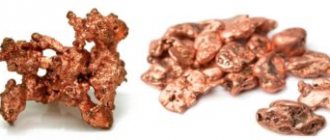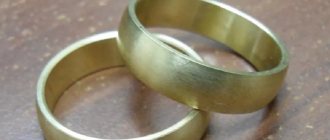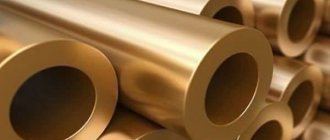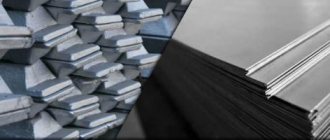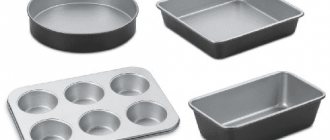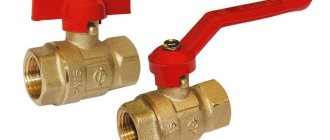To buy a truly high-quality, durable and reliable faucet for your home, you should be extremely careful and study the information on the topic in advance. For example, tips on how to distinguish brass from silumin. Experts in this field will most clearly explain to readers how to distinguish silumin from brass in a mixer. It's actually quite easy to do. Modern faucets are made from a variety of materials. Their price and quality depend on this. But most often manufacturers use silumin and brass. The first material is an alloy of silicon and aluminum. It is used to create budget plumbing fixtures of low quality. Of course, it has a corresponding price. The main disadvantage of silumin faucets lies in its fragility. A strong, strong man can break such a product with his bare hands, without using any special tools.
The second type of material most often used today for the manufacture of faucets is brass. It is an alloy of zinc and copper. As you can already understand from the composition, this is a strong and reliable material. It will serve its owner for many years and will always delight with its excellent quality. Without the need for even minimal repairs, brass faucets can last more than 5 years. Among their disadvantages, one can note only their high cost. Today in stores you can find brass plumbing fixtures made in Europe or China. Interestingly, faucets made from the material under discussion from Asian manufacturers are in no way inferior in quality. Therefore, you can also safely purchase them.
Some sellers, in order to increase prices for their goods, give incorrect information about what material the faucets they offer are made from. Therefore, it will be useful for each buyer to be able to independently understand this important issue. Experts note that on the modern market, more than 90 percent of plumbing products allegedly made of brass are fake. In appearance, they are almost impossible to distinguish from silumin faucets. The thing is that both types use the same external coating - chrome. Therefore, when choosing, you need to focus on other signs. The first step is to pick up the product you like. If it is really made of high-quality durable material, then its weight will exceed 3 kilograms. This can usually be determined without scales. Faucets that are too light are probably silumin.
Having dealt with the weight of the product, you will need to study its internal part. For a quality product, this surface will be yellow in color and smooth to the touch. This is because brass faucets are always produced by casting. Only at the next stage are they mechanically processed. Therefore, there will definitely be no roughness or other imperfections inside the product. Silumin mixers cannot be created in a similar way. This material is extremely fragile, so joints, depressions and irregularities will always be visible on it. The main thing is not to be shy about studying the mixer so closely and in detail. It depends on how high-quality, strong and durable the product can be purchased. You can safely ask the seller, among other things, to show documents for the product, which will indicate its material.
Plumbing products made from brass always look very simple and concise. The special technology of their manufacture does not allow creating any decorations or patterns on the surface. When choosing a mixer, you should also pay attention to its labeling. Silumin is marked with the letters “AL”, and the alloy of zinc and copper is marked with the letter “L”. This information is usually provided in the technical data of the product.
When replacing plumbing fixtures in the bathroom or kitchen, problems arise in choosing faucets. Today the range and price range is very wide. In large chain stores you can find a mixer for 300 rubles, and in front of it there may be a similar one in appearance, but for 5,000 rubles. The buyer has questions about the difference between the two. This article was created to answer several of these questions.
Features of brass faucets
This material is a mixture of copper and zinc alloy, the latter giving better machinability, making the faucet much cheaper than its pure copper counterpart. In addition, it gives brass increased corrosion resistance and the ability to withstand sudden temperature changes, so such faucets can serve reliably for a long period of time without losing their performance properties.
Initially, brass has a light golden color (which is why it is also used in the jewelry industry), but in most cases, taps are coated with another material: nickel, bronze or chrome, with the latter being the most common. The chrome surface shines with a mirror-like shine, but stains and fingerprints remain on it, so it requires more frequent cleaning than matte. Nickel-plated faucets have it.
There are also taps with a coating that is similar to bronze. The characteristic brown tint is given to it by the epoxy resins contained in the composition. This option is much higher quality and more reliable than products made from pure bronze.
There are also elite gold-plated or silver-plated models that will look luxurious in rich interiors.
Brass faucets are durable, easy to repair (and European manufacturers of plumbing fixtures, as a rule, use the same standard sizes) and durable (their service life reaches 5 years or longer), but they also have disadvantages. For example, they are not very resistant to scratches and chips, but this does not affect their performance.
If you purchase a brass faucet without a surface coating, keep in mind that over time a greenish coating will form on it, which, however, can be easily removed with improvised means. In addition, the cost of brass taps is often too high.
Nowadays a trend has emerged among interior designers - multi-colored faucets. They are given the required color or pattern using powder coating.
Brass taps are used absolutely everywhere: in apartments and public places, in kitchens and bathrooms. Depending on the design and coating, they can fit into any interior style: from classic to modern.
Sometimes manufacturers, wanting to save money, make brass faucet handles from plastic. This is an unreliable option that should be avoided as much as possible.
Choosing a shower head
Popular materials are metal and plastic. Metal elements are durable and expensive. Plastic is cheaper, but has a shorter service life. It is easy to break if handled carelessly.
| TIP! Many cascade type faucets do not look like traditional faucets. They are disguised as a shelf on the wall, produced on a metal leg, in the form of a lamp, etc. |
Shower heads can have several modes of supply and spray of water flow. This can be jet, drip, or massaging irrigation. Type of installation of the element: manual, on the wall or ceiling. If you choose the manual option, you should purchase an additional holder. It will have to be mounted into the wall.
Characteristics of silumin mixers
This material consists of approximately 90% aluminum and 10-15% silicon (or, in more complex alloys, contains other alloying elements). It was invented in the 20th century and used in aircraft production, as well as in shipbuilding and space industrial activities. Plumbing fixtures began to be made from it relatively recently.
At the moment, silumin occupies about 55% of the plumbing fixtures market.
Thanks to the properties of silumin, the crane is characterized by lightness, wear resistance and corrosion resistance. In addition, it is distinguished by its plasticity and ease of processing, so there are a huge number of design solutions for such products. On the plumbing market you can find silumin faucets for every taste.
But they have disadvantages, more significant than their advantages. This is a very short service life, which takes no more than a year and a half. After this, users of such faucets complain about leaks and breakdowns, and repairs in this case do not help: when replacing the gasket or sealing cracks, the leak appears in another place after a short time. Therefore, only a complete replacement of the device will be cheaper and more effective.
In addition, faucets made of silumin very quickly lose their presentation, becoming covered with scratches and abrasions. The inside of the faucet quickly becomes covered with limescale, which can lead to blockage.
Also, silumin mixers are incredibly fragile: you can literally break them with your hands.
The question may arise - why is such plumbing needed? Typically, silumin taps are purchased for dachas, since they are not used there as often as in houses, and therefore they last longer. Moreover, they usually have the lowest price of all materials.
For the same reason, they are purchased for temporary housing.
Design and colors
Plumbing products play no less a role in interior design than household appliances. The mixer should ideally fit the sink not only in size, but also in design, so it is better to buy equipment together and from the same series.
When choosing a kitchen faucet, interior designers recommend using the following rules. For a high-tech style, you should choose a laconic single-lever device of a simple shape coated with chrome. A good choice would be a faucet with a thermostat. For interiors in retro and Provence style, the best solution would be to choose a two-valve faucet made in gold, copper or bronze. In a Scandinavian-style kitchen, a stainless steel or stone-effect faucet will look great.
When choosing the color of the device, you should not only focus on the color of the sink, but also take into account additional factors. Both the overall color line of the set and some specific aspects matter, for example, the shade of handles on cabinets and drawers, the design of the kitchen apron, and the presence of decorative elements. For a square sink, an L-shaped faucet is better suited; for a round and oval sink, a device with a round spout is better suited.
How to distinguish brass from silumin
Outwardly, they are in no way different from each other - both can have either a shiny or matte surface, as well as a wide variety of designs. But there are some details.
First of all, it's cost. For a silumin mixer it will always be lower than for a brass one. So you will have to pay more for durability, but in this case the benefit is 100% payback.
Another nuance is weight. Silumin is lighter. However, this was the case until recently; now manufacturers have learned to add heavy metals to it in order to pass it off as another material.
Be sure to check the technical documentation of the product: it should be marked “Al”. If you see the letter “L”, then most likely you are dealing with silumin.
As already stated, this point doesn't matter when your main goal is to save money. If long service life is important to you, brass is the leader by a huge margin.
So we figured out how these materials differ from each other, and which one is better according to various criteria. But which of these is more important is up to you to decide for yourself.
Silumin or brass - choice of mixer
Plumbing equipment breaks down at the most inopportune moment. In a store, you hastily buy a seemingly decent faucet at a very low price, suspecting nothing. And a few months later, history repeats itself - the material turned out to be too weak. In the article a master plumber will tell you how to choose high-quality plumbing fixtures, silumin or brass, and which faucet is better.
Science and industry go hand in hand. New scientific achievements are designed to improve the quality of life, including reducing the cost of production not only as a process, but also the product itself. At the same time, quality often suffers, as happened with silumin in consumer goods.
Silumin is an alloy of aluminum, silicon and various metal additives in small quantities. Developed in the 20th century. It retained its light weight and ease of processing, but became stronger than aluminum, although softer than duralumin (used in the aviation industry). It is used for the manufacture of boat motors and other products where strength and lightness are important.
Brass is an alloy of copper and zinc, known even before our era. Its main properties are corrosion resistance and strength. Since ancient times, it has been used to create weapons and jewelry (fake gold).
Since the beginning of the construction of production machines, including steam ones, brass has become an integral material for mechanisms. Gears were made from it, including those that took on a large load. Now it is used in the production of gas turbines, chemical equipment, and equipment for the food industry. Nuts and fittings made from this material are used in various industries, in construction and in everyday life.
It seems like good materials, but what's the catch? Let's look at it one by one. Brass
Silumin and brass faucets: which material to choose
There are silumin and brass faucets on the plumbing market. Their prices are noticeably different. Let's find out what the difference is and which product to give preference to.
Silumin and brass are the main materials from which faucets are made. There are a large number of enthusiastic reviews about silumin mixers, and there are no less fans of brass fixtures.
Finally
As for the price of mixers, it varies from 1,000 to 60,000 rubles. The differences depend on the material the faucet is made from and where you purchase it from. In dubious places you will buy a “branded” mixer for 1000-2000 rubles, but no one will give you a guarantee of operation. It is better to contact specialized stores when purchasing such things.
- You will find good reviews about expensive German (Hansa, Grohe), Italian (Fari, Fiori), Polish (Ferro), Czech (Imprese) faucets.
- From the middle price category, Emivi (Italy), Vidima (Bulgaria) and Mixxen (Spain-China) are praised.
- Among the budget (cheap) options, pay attention to the mixers Rossinka (Russia-China), Santekhpribor (Russia), Ukrsanlit (Ukraine).
When replacing plumbing fixtures in the bathroom or kitchen, problems arise in choosing faucets. Today the range and price range is very wide. In large chain stores you can find a mixer for 300 rubles, and in front of it there may be a similar one in appearance, but for 5,000 rubles. The buyer has questions about the difference between the two. This article was created to answer several of these questions.
What is silumin
Silumin is an alloy of aluminum and silicon. The composition may contain impurities of copper, titanium, magnesium and manganese, which are added specifically. The presence of iron, calcium, and zinc indicates insufficient purification of the substance. It is not uncommon for sodium or lithium to be present.
Aluminum is the basis of the alloy: its content is about 90%. This explains the external and qualitative similarity of aluminum and silumin. Both metals are gray, silvery when cut, and have low density. Like aluminum, silumin is not afraid of corrosion due to a protective film of oxide compounds.
The physical properties of silumin depend on the second component. Silicon makes it strong and wear-resistant. The material can withstand heavy loads, but up to a certain point. After passing the strength threshold, silumin becomes brittle and brittle.
Aluminum-silicon compounds have a low melting point - about 670 °C. Because of this, the cost of the alloy is lower than that of other metallic substances.
You might be interested
Marking
Silumin can be marked in various ways. The international ISO system imposes certain requirements on alloys. Let's look at some brands as an illustrative example:
- AK 15. The letters “A” and “K” correspond to the components: aluminum and silicon, respectively. The number in turn indicates the percentage of the second most important component in the alloy;
- AL 9. The letter “L” in this case indicates the presence of lithium in the composition.
Sometimes the percentage value of another component, which is included in large quantities in the alloy, may be added to the marking, for example:
AK 15 Ts8. “Ts8” means that the alloy contains 8% zinc.
The Aluminum Association system has been created for the international market. When using this system, a four-digit code is used, in which the first digit is “4” (indicates the alloying system), the second digit carries the serial number of the alloy modification, the third and fourth are the composition of the alloy and information about its purity. In the case of using an experimental casting, an “X” is added to the marking.
In the post-Soviet space, GOST is more often used for marking; in this case, the alloys will also be designated by a four-digit code, for example, 1319. In this case, the number “1” at the beginning indicates the main element - aluminum. The second number indicates the alloying system, and the subsequent ones indicate the grade and modification of the alloy.
Silumin mixers
Products made from an aluminum alloy with silicon are economy-class plumbing fixtures.
Silumin mixers have the following advantages:
- Strength;
- Corrosion resistance;
- Wear resistance;
- Light weight;
- Low cost.
But these advantages give way to serious disadvantages, the main one of which is fragility. Temperature changes, pressure changes, careless installation and other factors can render the faucet unusable within a few months.
Silumin mixers cannot be repaired. Even if you managed to select a gasket and pack the cracked product tightly, it will soon leak in another place.
Alloy groups
Silumin alloys are divided into several groups. This distinction is made according to the purpose of the materials:
- AK 12 is a eutectic silumin containing 12% silicon. During heat treatment, the casting is not strengthened and does not become hard during shrinkage. Parts made of such material are structurally designed for sealed low-load devices.
- Highly alloyed hypereutectic silumin is labeled, for example, AK4M5. Belongs to the piston group and is used when performing work under high-temperature conditions. It has high resistance to high temperatures and wear resistance. The use of this alloy for particularly important products operating under high load conditions. These are large-sized and critical parts.
What is brass
This is an alloy based on copper and zinc. The amount of additional component does not exceed 30%. Zinc is cheaper than copper, and therefore the higher the content of the former, the lower the cost of the material. But such a solution worsens the quality of the finished alloy.
Let's consider how additives affect the properties. The brass composition is diluted:
- Nickel (increases strength and corrosion resistance);
- Tin (solves the problem of rust in salt water);
- Silicon (increases anti-friction qualities, but reduces hardness and strength);
- Lead (simplifies processing, reduces strength);
- Manganese (anti-corrosion component that improves mechanical characteristics, the effect is further enhanced by tin, aluminum, iron).
Brass alloy is the most popular in the world. Due to its high strength and wear resistance, it is called the “eternal metal”. The material does not rust and is not afraid of aggressive external factors.
The melting point reaches 950 °C. For this reason, and also because of the high cost of copper, the production of the alloy is more expensive than the production of silumin. They reduce the price by increasing the zinc content. Changing the proportion simplifies the technology for preparing the alloy, but with a zinc content of 20% or more, brass cracks in a humid environment.
Brass faucets
Plumbing fixtures made of copper-zinc alloy belong to the luxury class. Brass faucets are valued for the following advantages:
- Strength and hardness;
- Wear resistance;
- Reliability and durability.
Copper-zinc products will last at least five years. Brass plumbing looks solid and is quite heavy. Thick cast walls and correct threaded connections minimize the likelihood of leakage. This type of plumbing can be repaired. The selection of parts is also simplified by the fact that European manufacturers of plumbing fixtures use the same standard sizes. At the same time, Chinese companies allow a difference of several millimeters.
A significant disadvantage of brass faucets is their high cost. But if you take into account the service life, the purchase will be profitable.
How to distinguish a silumin faucet from a brass one
First of all, focus on cost. For a brass faucet it is an order of magnitude higher than for a silumin faucet. Aluminum-based products are more often offered by Chinese manufacturers. It is difficult for a non-professional to determine it by eye. Focus on weight - silumin products are light, as if they were plastic. But some manufacturers practice adding weights to make budget products pass for luxury. Therefore, always check the product documents.
This will avoid purchasing a low-quality brass faucet. Products with a high zinc content in operation resemble silumin. A leak can form within a month. But only in this case it is more likely to appear not even on the thread, but on solid elements. In addition, low copper content creates the danger of zinc leaching, which negatively affects the quality of tap water.
You might be interested
Price
As for the price of this material, it is quite low, about 80 rubles per 1 kg. alloy But the prices for goods made from this alloy are already an order of magnitude higher, but also quite inexpensive when compared with goods made from pure metal.
19.02.2020 911
go to sections
Items you may be interested in:
Bust of Pushkin A.S.
Ancient bust of Pushkin A.S. era of the USSR. Small item. Has obvious signs of time, scuffs, dents, scratches. This bust of Pushkin is... 1500 ₽
Bust of Gagarin Yu. A.
Bust of the first man in space - Yuri Alekseevich Gagarin. Yu.A. Gagarin - Soviet pilot-cosmonaut, hero of the Soviet Union, April 12, 1961... 0 ₽
Which mixer to choose
It is always better to give preference to high-quality and durable brass plumbing fixtures. By installing such faucets in the bathroom and kitchen, you don’t have to worry about breakdowns and flooding.
In an office, cafe, restaurant, or in any public bathroom where taps are used intensively, you should install reliable brass plumbing fixtures.
Sometimes it is still more rational to choose a more budget-friendly silumin product. If the pressure in the system does not exceed 3 bar, the budget mixer is likely to last a long time. At the dacha, such plumbing will perform best. But in a new building or in a private house, where the pressure is higher, the available mixer will be “disposable” - the very first water hammer will destroy the structure.
It is also worth choosing silumin if there is no hot water supply.
When choosing a faucet, remember that this purchase is designed to serve you as long as possible, but take into account all the criteria so as not to overpay if high quality is not necessary.
Review: Ledeme faucets - How to avoid becoming a victim of deception? Brass or silumin?
Hi all! I continue the topic of bathroom renovations and today I want to tell you about the TM Ledeme faucet. Most people probably know that the best brand for plumbing is the German manufacturer Grohe, because it’s not for nothing that this brand of plumbing is in many public places where there is a constant flow of people. My father-in-law, who has been doing repairs for many years and knows a lot about these things, also considers Grohe to be the best. True, for German quality you have to pay a little, or maybe a lot, more than other mid-price mixers from other brands cost.
Since our family budget was on the verge of bankruptcy by the time the renovation was completed, and the mixer had not yet been purchased, we had to come to terms with the fact that we could not afford German quality and choose a simpler option. Before buying a mixer, I deliberately did not go online and look at reviews and ratings of this or that TM, so as not to get upset in advance and choose what I like according to my feelings.
A LITTLE BACKGROUND: “HOW TO NOT BECOME A VICTIM OF DECEPTION?” Since there was very little choice in the nearby plumbing stores, we went to the construction market. In one of the retail outlets you could pick up something, since the mixers were beautifully placed in several rows in a row and there were very, very many of them. In general, there was a huge choice and then we turned to the seller for help. The salesperson helped us choose the faucet that we needed in size and shape, and I no longer began to pay any attention to the company. The woman assured me that the faucet was made of brass and was manufactured, as it is fashionable to say now, in China. Actually, at first glance, the mixer inspired confidence and was heavy (more than 1 kg), so I purchased it without much hesitation. By the way, I paid 3,400 rubles for it.
Arriving home, I began to study the information, since the company was completely unfamiliar to me - Loffrey (article LF81070), but I did not find a single review for it. This alarmed me a little, I started looking for information all over the World Wide Web, and not just on Otzovik, but there were no reviews there either. I decided to find out more about the manufacturer and then an unexpected surprise awaited me: it turned out that the Loffrey company is an economy branch of the Ledeme TM. But my disappointments did not end there: in all online stores where this mixer was sold, the price for it was 2 times less than the one for which I purchased it. And then it turned out that the material from which the mixer was made was not brass, as the seller assured me, but powdered silumin. This was written about in all the online stores I looked at. I began to find out further what silumin is. It turned out that this is an alloy of aluminum with silicon, a cheap, low-quality material that quickly becomes unusable due to its fragility and unreliability. I saw enough photos on the Internet of faucets with holes, pieces torn out, simply cracked in half, which become so unusable after only a couple of months. To say that I was shocked is an understatement.
But since the mixer was heavy, and the main difference between silumin and brass is the weight, I thought that perhaps my mixer was still made of brass and they sell cheap analogues on the Internet. By the way, the seller made sure that there were no instructions or other pieces of paper in the packaging box; there was no place for me to see the material from which the mixer was made. I emailed the manufacturer with this question and they answered that all TM Loffrey faucets are made of silumin. It turns out that everything is simple: the Chinese have learned to mix heavier metals into silumin in order to increase the weight of the product. Shock gave way to anger: why did I pay 3,400 rubles, because I was scammed like a l? (simple) ear, excuse me?!
The father-in-law came to install the purchased device, told him everything, and he set out on the same feet to return it. Before this, I stopped by some familiar plumbing sellers, from whom I often shop for work. He told them everything, they looked at the product, confirmed that it was not brass at all, and said that they didn’t even buy that kind of stuff. Everyone laughed, of course, and said that you need to know how to sell a product like that. I was not laughing, the only consolation was that my father-in-law returned with the same faucet (shape, size, model), only now made 100% of brass. And we bought it even a little cheaper - for 3,300 rubles.
How to distinguish brass from silumin by appearance and touch?
When choosing plumbing fixtures for your home, every owner should know how to distinguish brass from silumin. This will allow you to protect yourself from purchasing low-quality Chinese goods, which may break after just a couple of months of use.
- Knowledge on the topic
- Attentiveness
To buy a truly high-quality, durable and reliable faucet for your home, you should be extremely careful and study the information on the topic in advance. For example, tips on how to distinguish brass from silumin. Experts in this field will most clearly explain to readers how to distinguish silumin from brass in a mixer. It's actually quite easy to do. Modern faucets are made from a variety of materials. Their price and quality depend on this. But most often manufacturers use silumin and brass. The first material is an alloy of silicon and aluminum. It is used to create budget plumbing fixtures of low quality. Of course, it has a corresponding price. The main disadvantage of silumin faucets lies in its fragility. A strong, strong man can break such a product with his bare hands, without using any special tools.
The second type of material most often used today for the manufacture of faucets is brass. It is an alloy of zinc and copper. As you can already understand from the composition, this is a strong and reliable material. It will serve its owner for many years and will always delight with its excellent quality. Without the need for even minimal repairs, brass faucets can last more than 5 years. Among their disadvantages, one can note only their high cost. Today in stores you can find brass plumbing fixtures made in Europe or China. Interestingly, faucets made from the material under discussion from Asian manufacturers are in no way inferior in quality. Therefore, you can also safely purchase them.
Some sellers, in order to increase prices for their goods, give incorrect information about what material the faucets they offer are made from. Therefore, it will be useful for each buyer to be able to independently understand this important issue. Experts note that on the modern market, more than 90 percent of plumbing products allegedly made of brass are fake. In appearance, they are almost impossible to distinguish from silumin faucets. The thing is that both types use the same external coating - chrome. Therefore, when choosing, you need to focus on other signs. The first step is to pick up the product you like. If it is really made of high-quality durable material, then its weight will exceed 3 kilograms. This can usually be determined without scales. Faucets that are too light are probably silumin.
Having dealt with the weight of the product, you will need to study its internal part. For a quality product, this surface will be yellow in color and smooth to the touch. This is because brass faucets are always produced by casting. Only at the next stage are they mechanically processed. Therefore, there will definitely be no roughness or other imperfections inside the product. Silumin mixers cannot be created in a similar way. This material is extremely fragile, so joints, depressions and irregularities will always be visible on it. The main thing is not to be shy about studying the mixer so closely and in detail. It depends on how high-quality, strong and durable the product can be purchased. You can safely ask the seller, among other things, to show documents for the product, which will indicate its material.
Plumbing products made from brass always look very simple and concise. The special technology of their manufacture does not allow creating any decorations or patterns on the surface. When choosing a mixer, you should also pay attention to its labeling. Silumin is marked with the letters “AL”, and the alloy of zinc and copper is marked with the letter “L”. This information is usually provided in the technical data of the product.
Knowledge on the topic is the key to success
To avoid making a mistake when buying a faucet, you need to be not only attentive, but also careful. Today on sale you can find many sanitary ware products from China, which are not of good quality. It is very important to understand in advance how to distinguish a silumin faucet from a brass one, because it is unlikely to be determined by appearance. Not all buyers are specialists well versed in this issue. And what criteria should one focus on here if there is no special knowledge?
In fact, to understand how to determine whether a brass or silumin faucet is a faucet, there is no need to graduate from a university or attend any courses. Even someone who has not purchased such products at all can figure this issue out. Here you only need attentiveness and some knowledge of which of the proposed materials is best. And the second thing, without which it will not be possible to make the right choice, is attentiveness. Every little detail must be taken into account to prevent an irreparable mistake.
